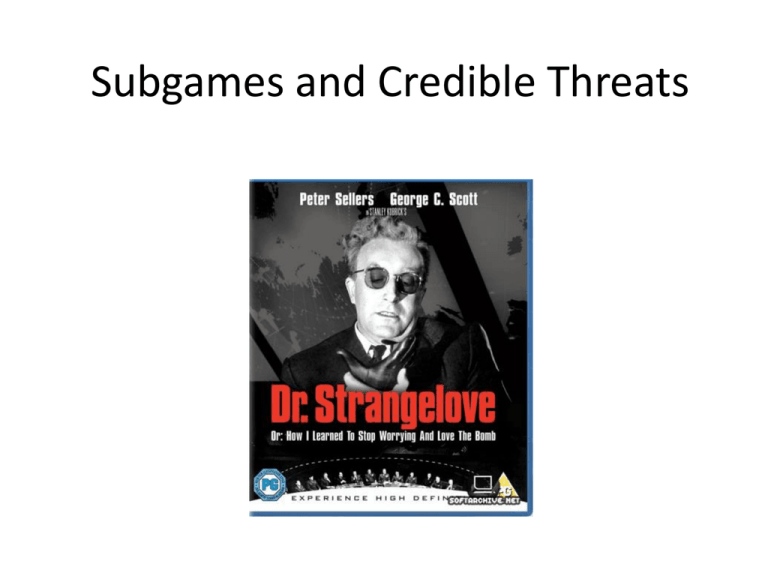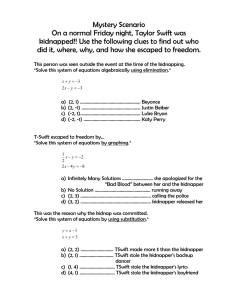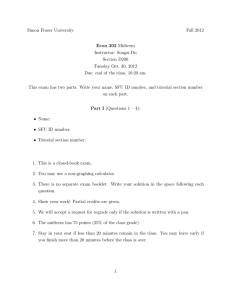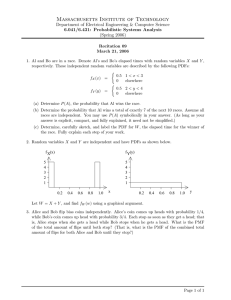Lecture 9 (Subgame Perfection)
advertisement

Subgames and Credible Threats Russian Tanks Quell Hungarian Revolution of 1956 The background • After WW II, the Soviet army occupied Hungary. • Ultimately, the government came under Soviet control. • In 1956, with U.S. encouragement, Hungarians revolted and threw out the Soviet-backed government. • Russia did not like this outcome. • The Hungarians appealed to the U.S. for support. What should U.S. do? • The U.S. did not have a large enough ground force in Europe to deal effectively with the Soviet army in Eastern Europe. • The U.S. did have the nuclear capacity to impose terrible costs on Russia. • But nuclear war would be very bad for everyone. (radioactive fallout, possibility of nuclear retaliation) Nuclear threat USSR Invade Don’t Invade Hungary US 0 1 Give in 5 0 Bomb USSR -10 -5 Nuclear threat (strategic form) Soviet Union Invade Give in if USSR Invades Don’t Invade 0, 5 1, 0 United States Bomb if USSR Invades -5,-10 1, 0 How many pure strategy Nash equilibria are there? A) 1 B) 2 C) 3 D) 4 Are all Nash Equilibria Plausible? • What supports the no-invasion equilibrium? • Is the threat to bomb Russia credible? • What would happen in the game starting from the information set where Russia has invaded Hungary? Nuclear threat USSR Invade Don’t Invade Hungary US 0 1 Give in 5 0 Bomb USSR -10 -5 Now for some theory… Reinhard Selten John Harsanyi John Nash Thomas Schelling Subgames in Games of Perfect Information • A game of perfect information induces one or more “subgames.” These are the games that constitute the rest of play from any of the game’s information sets. (decision nodes) • A subgame perfect Nash equilibrium is a Nash equilibrium in every induced subgame of the original game. Backwards induction in games of Perfect Information • Work back from terminal nodes. • Go to final ``decision node’’. Assign action to the player that maximizes his payoff. (Consider the case of no ties here.) • Reduce game by trimming tree at this node and making terminal payoffs at this node, the payoffs when the player whose turn it was takes best action. • Keep working backwards. What if the U.S. had installed a Doomsday machine, a la Dr. Strangelove? The Doomsday Game Similar structure, but less terrifying: The entry game Challenger Challenge Stay out Incumbent Give in 1 0 0 1 Fight -1 -1 Alice and Bob Revisited: (Bob moves first) Bob Go to A Go to B Alice Go to A 2 3 Alice Go to B 0 0 Go to A 1 1 Go to B 3 2 Strategies • For Bob – Go to A – Go to B • For Alice – – – – Go to A if Bob goes A and go to A if Bob goes B Go to A if Bob goes A and go to B if Bob goes B Go to B if Bob goes A and go to A if Bob goes B Go to B if Bob goes A and go B if Bob goes B • A strategy specifies what you will do at EVERY Information set at which it is your turn. Strategic Form Alice Bob Go where Bob went. Go to A no matter what Bob did. Go to B no Go where matter what Bob did not Bob did. go. Movie A 2,3 2,3 0,0 0,1 Movie B 3,2 1,1 3,2 1,0 How many Nash equilibria are there for this game? A) 1 B) 2 C) 3 D) 4 Alice and Bob (Bob moves first) Bob Go to A Go to B Alice Go to A 2 3 Alice Go to B 0 0 Go to A 1 1 Go to B 3 2 How many subgame perfect N.E. does this game have? A) There is only one and in that equilibrium they both go to movie A. B) There is only one and in that equilbrium they both go to movie B. C) There are two. In one they go to movie A and in the other tney go to movie B. D) There is only one and in that equilibrium Bob goes to B and Alice goes to A. Two subgames Bob went A Bob went B Alice Go to A 2 3 Alice Go to B 0 0 Go to A 1 1 Go to B 3 2 Alice and Bob (backward induction) Bob Go to A Go to B Alice Go to A 2 3 Alice Go to B 0 0 Go to A 1 1 Go to B 3 2 Alice and Bob Subgame perfect N.E. Bob Go to A Go to B Alice Go to A 2 3 Alice Go to B 0 0 Go to A 1 1 Go to B 3 2 Backwards induction in games of Perfect Information • Work back from terminal nodes. • Go to final ``decision node’’. Assign action to that maximizes decision maker’s payoff. (Consider the case of no ties here.) • Reduce game by trimming tree at this node and making terminal payoffs the payoffs to best action at this node. • Keep working backwards. A Kidnapping Game Kidnapper Don’t Kidnap Kidnap Relative Don’t pay Pay ransom Kidnapper Kill 5 1 3 5 Kidnapper Release 4 3 Kill 2 2 Release 1 4 A Kidnapping Game Kidnapper Don’t Kidnap Kidnap Relative Don’t pay Pay ransom Kidnapper Kill 5 1 3 5 Kidnapper Release 4 3 Kill 2 2 Release 1 4 A Kidnapping Game Kidnapper Don’t Kidnap Kidnap Relative Don’t pay Pay ransom Kidnapper Kill 5 1 3 5 Kidnapper Release 4 3 Kill 2 2 Release 1 4 A Kidnapping Game Kidnapper Don’t Kidnap Kidnap Relative Don’t pay Pay ransom Kidnapper Kill 5 1 3 5 Kidnapper Release 4 3 Kill 2 2 Release 1 4 In the subgame perfect Nash equilibrium A) The victim is kidnapped, no ransom is paid and the victim is killed. B) The victim is kidnapped, ransom is paid and the victim is released. C) The victim is not kidnapped. Another Kidnapping Game Kidnapper Don’t Kidnap Kidnap Relative Don’t pay Pay ransom Kidnapper Kill 4 1 3 5 Kidnapper Release 5 3 Kill 2 2 Release 1 4 In the subgame perfect Nash equilibrium A) The victim is kidnapped, no ransom is paid and the victim is killed. B) The victim is kidnapped, ransom is paid and the victim is released. C) The victim is not kidnapped. Another Kidnapping Game Kidnapper Don’t Kidnap Kidnap Relative Don’t pay Pay ransom Kidnapper Kill 4 1 3 5 Kidnapper Release 5 3 Kill 2 2 Release 1 4 Another Kidnapping Game Kidnapper Don’t Kidnap Kidnap Relative Don’t pay Pay ransom Kidnapper Kill 4 1 3 5 Kidnapper Release 5 3 Kill 2 2 Release 1 4 Another Kidnapping Game Kidnapper Don’t Kidnap Kidnap Relative Don’t pay Pay ransom Kidnapper Kill 4 1 3 5 Kidnapper Release 5 3 Kill 2 2 Release 1 4 Does this game have any Nash equilibria that are not subgame perfect? A) Yes, there is at least one Nash equilibrium in which the victim is not kidnapped. B) No, every Nash equilibrium of this game is subgame perfect. The Centipede Game in extensive form Backwards induction-Player 1’s last move Backwards induction- What does 2 do? One step further. What would 1 do? Taking it all the way back Twice Repeated Prisoners’ Dilemma Two players play two rounds of Prisoners’ dilemma. Before second round, each knows what other did on the first round. Payoff is the sum of earnings on the two rounds. Single round payoffs Player 2 Cooperate P L A Cooperate y E R 1 Defect Defect 10, 10 0, 11 11, 0 1, 1 Two-Stage Prisoners’ Dilemma Player 1 Cooperate Defect Player 2 Cooperate Player 1 C C 20 20 Playe Pl. 2 r1 D 10 21 D C Cooperate Defect Player 1 D C Player 1 C Pl 2 D C D Defect C D C Player 1 D C Pl 2 D C D Pl 2 D C 21 11 10 0 11 1 21 11 22 12 10 11 21 22 11 12 10 11 0 1 D C 11 2 12 11 12 1 D 2 2 Two-Stage Prisoners’ Dilemma Working back Player 1 Cooperate Defect Player 2 Cooperate Player 1 C C 20 20 Playe Pl. 2 r1 D 10 21 D C Cooperate Defect Player 1 D C Player 1 C Pl 2 D C D Defect C D C Player 1 D C Pl 2 D C D Pl 2 D C 21 11 10 0 11 1 21 11 22 12 10 11 21 22 11 12 10 11 0 1 D C 11 2 12 11 12 1 D 2 2 Two-Stage Prisoners’ Dilemma Working back further Player 1 Cooperate Defect Player 2 Cooperate Player 1 C C 20 20 Playe Pl. 2 r1 D 10 21 D C Cooperate Defect Player 1 D C Player 1 C Pl 2 D C D Defect C D C Player 1 D C Pl 2 D C D Pl 2 D C 21 11 10 0 11 1 21 11 22 12 10 11 21 22 11 12 10 11 0 1 D C 11 2 12 11 12 1 D 2 2 Two-Stage Prisoners’ Dilemma Working back further Player 1 Cooperate Defect Player 2 Cooperate Player 1 C C 20 20 Playe Pl. 2 r1 D 10 21 D C Cooperate Defect Player 1 D C Player 1 C Pl 2 D C D Defect C D C Player 1 D C Pl 2 D C D Pl 2 D C 21 11 10 0 11 1 21 11 22 12 10 11 21 22 11 12 10 11 0 1 D C 11 2 12 11 12 1 D 2 2 Longer Game • What is the subgame perfect outcome if Prisoners’ dilemma is repeated 100 times? How would you play in such a game? The seven goblins Dividing the spoils Goblins named A, B, E, G, K, R, and U take turns proposing a division of 100 coins. (no fractions) A proposes a division. He gets 4 or more votes for his division, it is applied. If he does not, then A doesn’t get to vote any more and B proposes a division. If B gets half or more of remaining votes, his division is applied. Otherwise proposal goes to E and B doesn’t get to vote any more. So it goes, moving down the alphabet. Backwards induction • If U gets to propose, then nobody else could vote and he would propose 100 for self. • But U will never get to propose, because if R gets to propose, R only needs 1 vote (his own) to win. He would give self 100, U gets 0. • If K gets to propose, he would need 2 votes. He could get U’s vote by offering him 1, offering R 0 and keeping 99. • Keep working back.. Proposers: A,B,E,G,K,R,U R proposes: needs 1 vote R-100, U-0 K proposes: needs 2 votes K-99, R-0, U-1 G proposes: needs 2 votes G-99,K-0, R-1, U-0 E proposes: needs 3 votes E-98, G-0,K-1,R-0, U-1 B proposes: needs 3 votes B-98,E-0,G-1,K-0,R-1,U-0 A proposes: needs 4 votes A-97,B-0,E-1,G-0,K-1,R-0,U-1 Reading Backward and Planning Forward…





